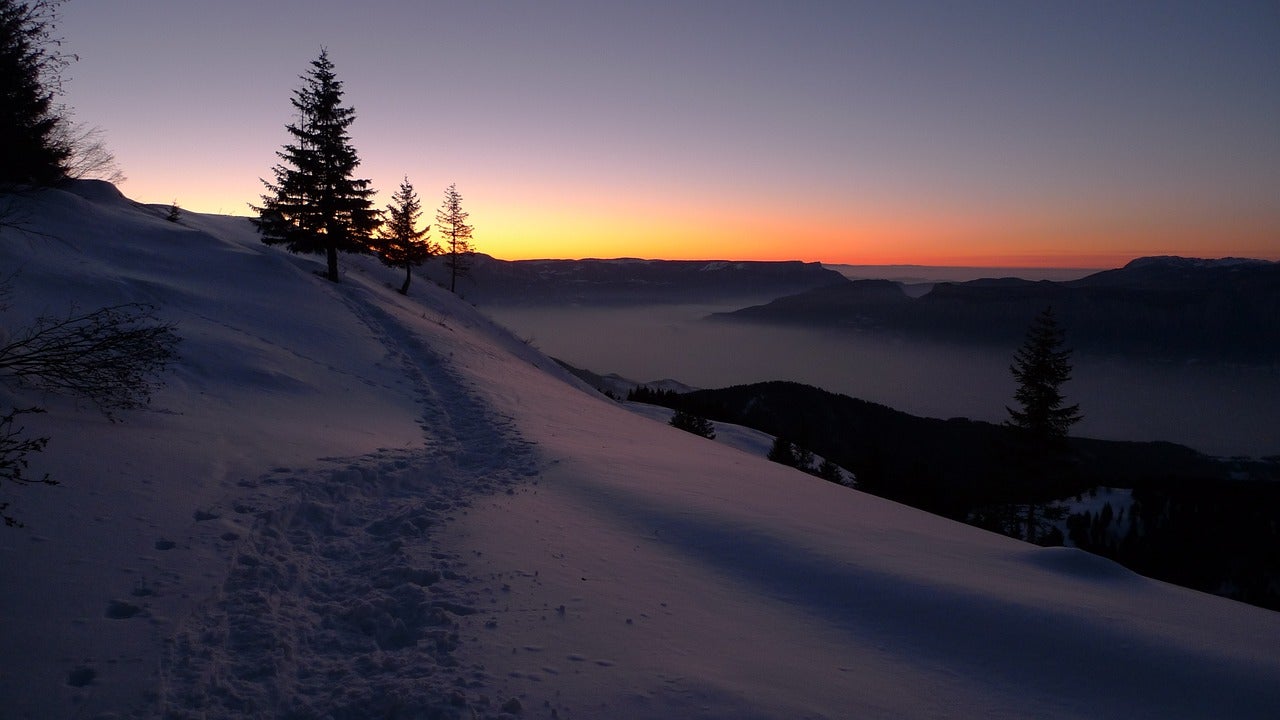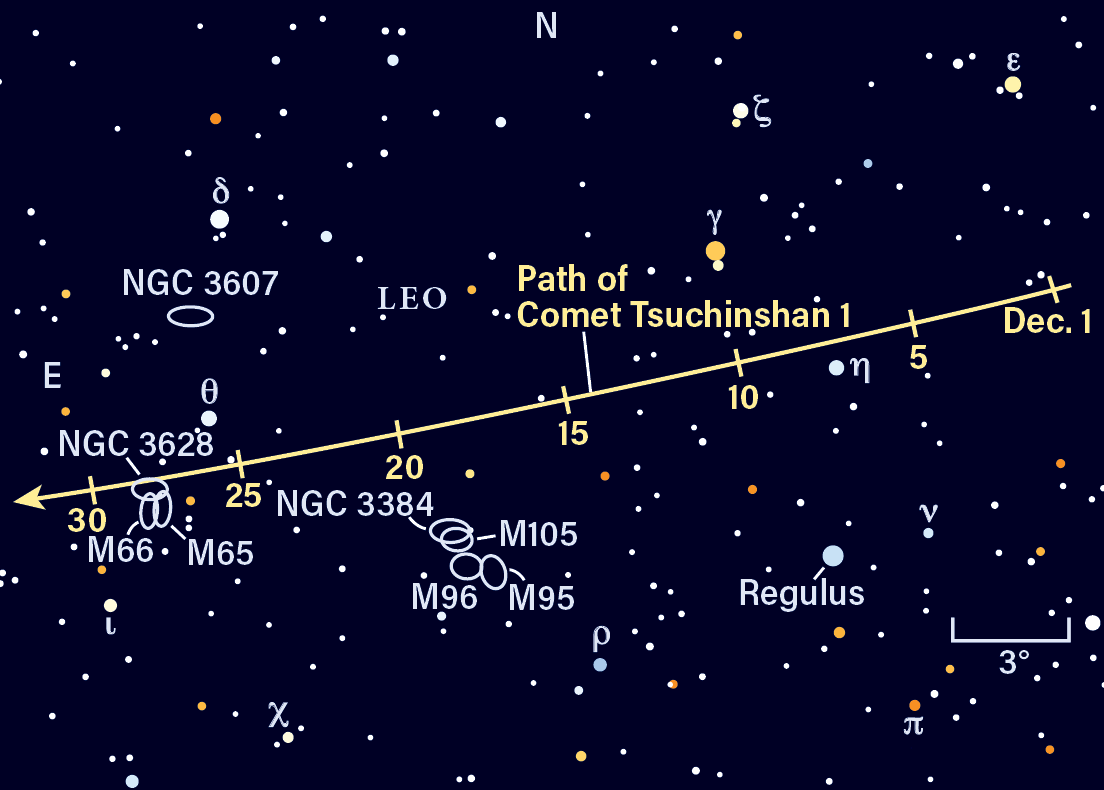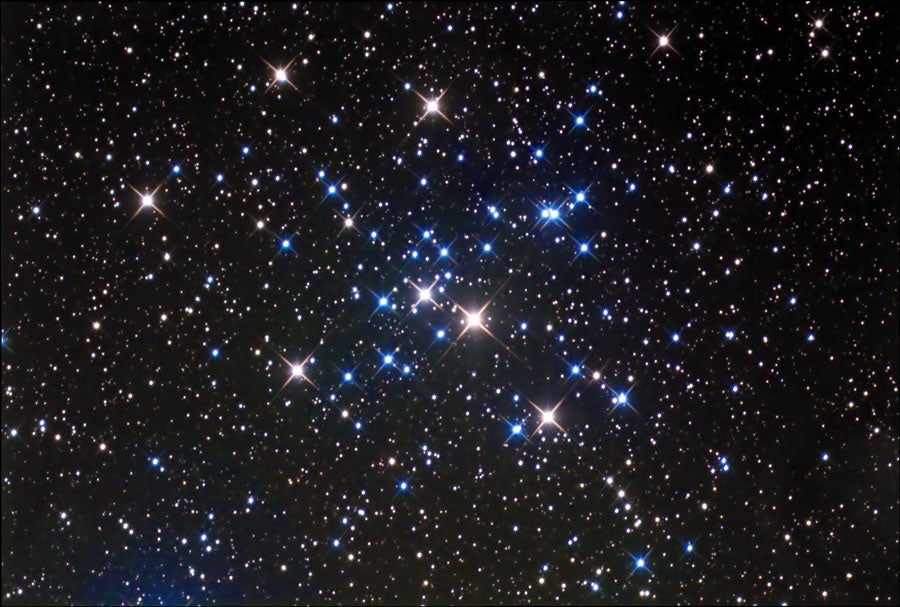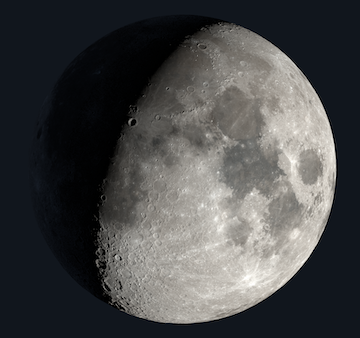
Friday, December 15
Asteroid 4 Vesta is skimming just south of several open star clusters near Gemini’s feet this evening. Just days from reaching opposition later this week, Vesta is currently an easy binocular object at magnitude 6.5. And it’s also in an easy-to-locate spot, just 12′ northwest of Chi2 (χ2) Orionis.
Once you’ve found Vesta, all you have to do is slide your field of view some 4° north to land on M35, glowing at magnitude 5.3. This open cluster is roughly 100 million years old and spans about half a degree, making it look best at lower magnifications and with wide-field eyepieces. Higher powers might show a smaller, more concentrated clump of stars to M35’s southwest — that’s magnitude 8.6 NGC 2158, another open cluster. And some 1.6° farther southwest is NGC 2129, a third open cluster that shines at magnitude 6.7. Even if you can’t spot NGC 2158, you’ll likely see the brighter, slightly larger NGC 2129.
Sunrise: 7:15 A.M.
Sunset: 4:35 P.M.
Moonrise: 10:07 A.M.
Moonset: 7:27 P.M.
Moon Phase: Waxing crescent (10%)
*Times for sunrise, sunset, moonrise, and moonset are given in local time from 40° N 90° W. The Moon’s illumination is given at 12 P.M. local time from the same location.

Saturday, December 16
The Moon reaches perigee, the closest point to Earth in its orbit, at 1:53 P.M. EST. At that time, Luna sits 228,603 miles (367,901 kilometers) away.
Speaking of the Moon, its light will soon start interfering with observations of Comet 62P/Tsuchinshan 1, so tonight is your best chance to get in a good look for a while. Rising in Leo an hour or two before local midnight, the comet has recently been recorded at magnitude 9, reachable with any telescope under a reasonably dark sky. The best time to observe Tsuchinshan 1 is in the last few hours of darkness before sunrise, when it is highest in the sky. Tsuchinshan 1 currently sits in the midst of the Lion’s body. To find it, first locate Leo’s brightest star, Regulus, and scan about 8.5° northeast.
The comet is not far from several great galaxies to observe: NGC 3384, M105, M95, and M96, as well as the Leo Trio of galaxies near the Lion’s hindquarters. Check out the chart above for the locations of these galaxies relative to Tsuchinshan 1 today.
After this, the Moon will interfere with observing, though deep photography may carry you through for a few more days. And astroimagers may especially want to try for some shots on the 28th, when Tsuchinshan 1 reaches the Leo Trio.
Sunrise: 7:15 A.M.
Sunset: 4:36 P.M.
Moonrise: 10:47 A.M.
Moonset: 8:44 P.M.
Moon Phase: Waxing crescent (18%)
Sunday, December 17
The Moon passes 2° south of magnitude 0.9 Saturn at 5 P.M. EST. It’s already growing dark on the East Coast, allowing observers there to easily spot the waxing crescent Moon hanging directly beneath the planet in the south. To the pair’s lower left, the bright star Fomalhaut in Piscis Austrinus may also begin to peek out from the twilight.
In time zones farther west, observers will see the Moon slowly crawl to Saturn’s left. It’s a great illustration of the way nearer objects appear to move faster against the background sky than those farther away. Luna now sits some 229,056 miles (368,630 km) away; Saturn is 938,850,000 miles (1.5 billion km) from Earth.
By 9 P.M. CST (after the planet has set in the Eastern time zone), the Moon and Saturn sit side by side, now nearly 3° apart. They are low in the west for Midwestern observers.
Through a telescope, Saturn’s spectacular rings are visible, about 37″ from end to end. The planet’s brightest moon, Titan, sits far to the east, some 2.5′ from Saturn’s center. Several fainter moons stand on the other side of the planet: Dione lies just south of the rings on Saturn’s western side, while Tethys (closer) and Rhea (farther) are roughly in line with the planet’s equator farther west. Enceladus — possibly too faint for many scopes — sits just north of the rings on Saturn’s western side.
Sunrise: 7:16 A.M.
Sunset: 4:36 P.M.
Moonrise: 11:20 A.M.
Moonset: 10:00 P.M.
Moon Phase: Waxing crescent (28%)

Monday, December 18
Canis Major is one of two loyal hunting dogs who follow Orion up into the sky on winter evenings. By about 9:30 P.M. local time, this constellation’s brightest star, Sirius, stands 15° above the southeastern horizon. This luminary is the brightest star in the sky, and tonight we’re using it to guide our way toward a colorful target: the open cluster M41.
From Sirius, you need only drop your gaze 4° due south to land on this sparkling star cluster. Under even modest magnifications of 14x, the glittering points of light will begin to show off contrasting colors of blue, orange, yellow, and red. A star’s color is generally an indicator of its temperature, as hotter stars appear blue or white, while cooler stars trend toward orange and red. M41 spans roughly 40′ and contains about 100 stars, including a bright red giant near the cluster’s center that shines at 7th magnitude. In truth, this single, aging luminary is some 700 times brighter than our Sun.
Sunrise: 7:17 A.M.
Sunset: 4:36 P.M.
Moonrise: 11:48 A.M.
Moonset: 11:13 P.M.
Moon Phase: Waxing crescent (39%)
Tuesday, December 19
The Moon passes 1.3° south of Neptune at 8 A.M. EST; our satellite then reaches First Quarter at 1:39 P.M. EST.
An hour after sunset, the Moon has moved east of Neptune and the two stand high in the south. The distant ice giant is not visible to the naked eye and you will need binoculars or a telescope to spot its magnitude 7.8 glow. The planet lies about 5° due south of Lambda (λ) Piscium, the southeasternmost star in the Circlet of Pisces.
Shift your gaze back up to Lambda, then look 2° to its northeast. You should land on a deep red magnitude 5 star. This is TX Piscium, also cataloged as 19 Piscium and the easternmost star in the Circlet. TX is a variable star known as a carbon star; these are some of the reddest stars in the sky, as carbon in their atmospheres scatters away any blue light they emit.
Sunrise: 7:17 A.M.
Sunset: 4:37 P.M.
Moonrise: 12:12 P.M.
Moonset: —
Moon Phase: First Quarter
Wednesday, December 20
Jupiter’s moon Io makes an easy-to-watch transit of the planet’s face tonight, starting just a few minutes before 10:30 P.M. EST. The gas giant shines brightly in Aries the Ram, making it simple to locate and zoom in on with a telescope to watch.
Io is followed — eventually — by its shadow, which appears over the cloud tops of the planet’s eastern limb an hour later (11:30 P.M. EST), just as Io is halfway through its east-to-west journey. The moon finishes its transit just after 12:30 A.M. EST on the 21st (note this is still late on the 20th in time zones farther west), its shadow now roughly centered on the planet’s prime meridian. Io continues to pull away to the west and the shadow finally disappears around 1:40 A.M. EST (early on the 21st for Eastern and Central time zones; still the 20th for the western half of the country).
You can also see the other three Galilean moons tonight: Ganymede lies alone far to the east, with Europa closer to Jupiter’s western limb than Callisto on the other side. Plus, Jupiter’s Great Red Spot makes an appearance, crossing the planet’s center around 11 P.M. EST. In fact, the storm and Io are roughly moving together, a real treat to see as the hours pass.
Sunrise: 7:18 A.M.
Sunset: 4:37 P.M.
Moonrise: 12:36 P.M.
Moonset: 12:24 A.M.
Moon Phase: Waxing gibbous (61%)

Thursday, December 21
Asteroid 4 Vesta reaches opposition today at 2 P.M. EST. The main-belt world is visible all night, roughly from sunset to sunrise, in the constellation Orion.
The winter solstice occurs at 10:27 P.M. EST, bringing the official start of winter to the Northern Hemisphere (and the start of summer in the Southern Hemisphere). On this day, the Sun takes its most southerly path through Northern Hemisphere skies. (When the winter solstice occurs in six months for the Southern Hemisphere, the Sun will accordingly take its most northerly path through the sky.)
Many people also think that the winter solstice is the shortest day and longest night in the Northern Hemisphere, but that’s not quite true. You can read why, as well as discover some other cool things about the winter solstice, in a past article from former Astronomy senior editor Rich Talcott (now a frequent contributing editor).
In addition to the solstice, today is special for another reason: We are seeing the waxing Moon fully face-on tonight. What does that mean? Over the course of a month, the Moon can appear to “nod” up and down as it orbits, an effect called libration. Sometimes we see more of its north pole, and sometimes more of its south pole. Today, we are looking directly toward the center of our satellite. In previous days, we were getting a peek at more southerly locales, but now we will start to view more of the northern regions as Luna begins to tilt its face back down, like a person nodding their head down to tuck their chin.
Sunrise: 7:18 A.M.
Sunset: 4:38 P.M.
Moonrise: 1:00 P.M.
Moonset: 1:36 A.M.
Moon Phase: Waxing gibbous (72%)
Friday, December 22
The Moon passes 3° north of Jupiter at 9 A.M. EST. We’ll catch them in the evening sky in next week’s column, so stay tuned.
In other planetary news, Mercury reaches inferior conjunction with the Sun, rendering it invisible to us for now, at 2 P.M. EST. We’ll start to see it again next month, after the new year.
Today, let’s home in on main-belt asteroid 9 Metis, which reaches opposition at 6 P.M. EST. The magnitude 8.4 asteroid lies in far southwestern Gemini, close to that constellation’s border with Taurus. This region rises shortly after sunset; give it a few hours to climb out of the horizon haze and by 7 or 8 P.M. local time, it should be ripe for observation.
If you have trouble recognizing Gemini by eye, Taurus’ V-shaped face and Orion’s three-star Belt are easy signposts. Gemini lies left of Orion and below Taurus. Metis is near the Twins’ feet, close to the two bright stars Elnath and Alheka, which mark the tips of Taurus’ horns. But the easiest way to find Metis is to first center on 3rd-magnitude Propus (Eta [η] Geminornum). About 2.3° northwest of this star is the 5th-magnitude open cluster M35, which we visited earlier this week.
From M35, continue northwest for 3.3° to arrive at Metis. The asteroid lies just 20′ southeast of a 6th-magnitude field star tonight, helping to aid in its identification. If you lock onto that star, you may notice Metis shift ever-so-slowly westward as the hours pass, though the motion is extremely subtle — try taking an image at the beginning and at the end of the night and compare the two.
Metis is one of the larger and more massive asteroids in the main belt. It’s about 105 miles (170 km) across and is likely a remnant from a much larger parent body that was broken up in a collision.
Sunrise: 7:19 A.M.
Sunset: 4:38 P.M.
Moonrise: 1:27 P.M.
Moonset: 2:46 A.M.
Moon Phase: Waxing gibbous (81%)

Sky This Week is brought to you in part by Celestron.
Editor’s Note: This article has been updated to clarify that the the winter solstice in the Southern Hemisphere occurs in June.









